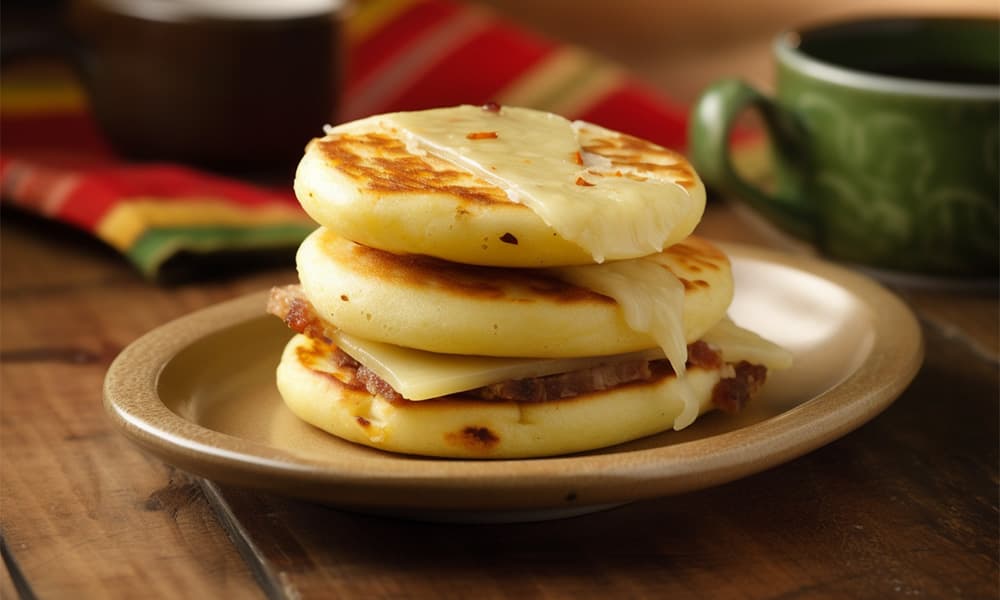From Caracas to Tokyo, passing through New York, Paris and Hong Kong, in street stalls and gourmet restaurants… The arepa, a corn-based dish, “conquers the world” driven by the exodus of Venezuelans escaping the crisis and the growing “gluten free” market.
It is prepared by mixing pre-cooked corn flour, salt and water. It is then shaped into a circle with the hands and cooked for a few minutes on a griddle or frying pan.
The fillings that can accompany it are an invitation to creativity. From leftovers in the fridge to more elaborate preparations such as the “reina pepiada”, the favorite of many Venezuelans, with chicken, avocado and mayonnaise.
“Many people ask me: How do you see the arepa in the world? And I see it conquering it,” says Venezuelan food critic Ricardo Estrada Cuevas, author of the book “Arepólogo: pan nuestro de cada día” (Arepologist: our daily bread).
“Where there is a Venezuelan, there is an arepa,” he assures. “They eat it every day, every night,” says Patrick Ribas, translator of the book. “You can put many rich things on it, whenever you want (…) but you can also eat it with nothing when you don’t have much money.”
More than 7 million Venezuelans – out of an estimated population of 30 – left the country because of a crisis that began in 2014 and contracted 80% of the economy. And they have taken the arepa with them in their suitcases.
A little trip to the Caribbean
Lawyer Marlyn Quiroga, 47, emigrated five years ago to New York, where she started “doing everything, like all emigrants who arrive”, but now she dedicates herself to cooking. He offers the catering service “Arepa La Newyorquina”, when before “he didn’t even know how to fry an egg”.
He began “knocking door to door in Queens: in beauty salons, doctors’ offices, offices (…) he gave samples for them to try. If the Arabs started like that in Venezuela, selling their products door to door, why shouldn’t we do it here?” he reflects.
He assures that at parties in New York they prefer arepas to bread, because they are “gluten free”. In Paris, Jean-François Lamaison sees the arepa as “a change from the hamburgers you find everywhere”. The 63-year-old is the digital designer of the restaurant “Ajidulce – Le goût du Venezuela” which promotes the “Arepa Power” with a sign.
“It has the merit of being a corn pancake with very good things (…) I like the diversity of flavors,” he says. The owner of the restaurant, Luis Fernando Machado, a Venezuelan oil engineer originally from Punto Fijo (in northwestern Venezuela), says they offer “homemade things with fresh products”.
“It’s a pleasure,” he adds, emphasizing that he stocks up on exotic groceries (Colombian, African, West Indian) in Paris. He left Venezuela in 2011, when he quit his job in the oil sector, and in 2014 launched a “food truck” of Venezuelan gastronomy. Helped by the success, he now also has a small restaurant in the 9th arrondissement of Paris that employs about ten people.
“Parisians are good customers, they like to discover exotic food and this is like taking a little trip to the Caribbean, to Venezuela,” explains Machado, whose kitchen is open so that “customers can see the preparation.”
Passion and love
He also claims to benefit from the growing desire for gluten-free products. “Customers are interested in having a complete gluten-free meal. Many tourists come (…) because we are well referenced among gluten-free restaurants”.
The fact that the arepa is a gluten-free food has been a benefit for Raúl Márquez, a 42-year-old Venezuelan who, together with his wife Miho, manages to attract consumers in Tokyo by highlighting that characteristic: “Healthy and gluten-free street food”, reads an advertisement on his food truck.
Marquez trained as a lawyer and left his country to learn to snowboard in Canada. He was also a winter surfing instructor in Hakuba, Japan, but now the food truck occupies most of his time. The Japanese flock to eat this exotic dish.
“Venezuela has been going through a difficult time (…) there is a strong emigration. We bring with us part of what belongs to us. Arepas are part of that. For me, an arepa is my mother. It is eating in the morning before going to school (…) that is what I put today when I sell arepas: this passion, this love that comes from home”, she says.
In Caracas, Lisbeth Márquez has a street stall where she prepares 1,300 servings daily. In addition, her go-to-work meal is… a potent arepa con pabellón: black beans, larded beef (shredded or shredded), an egg, grated cheese and melted butter on top of the steaming tortilla.
“It’s a creole food, we can accompany it with so many contornos. I never get tired of eating arepas. The best thing is the arepita de la casa,” he says.






